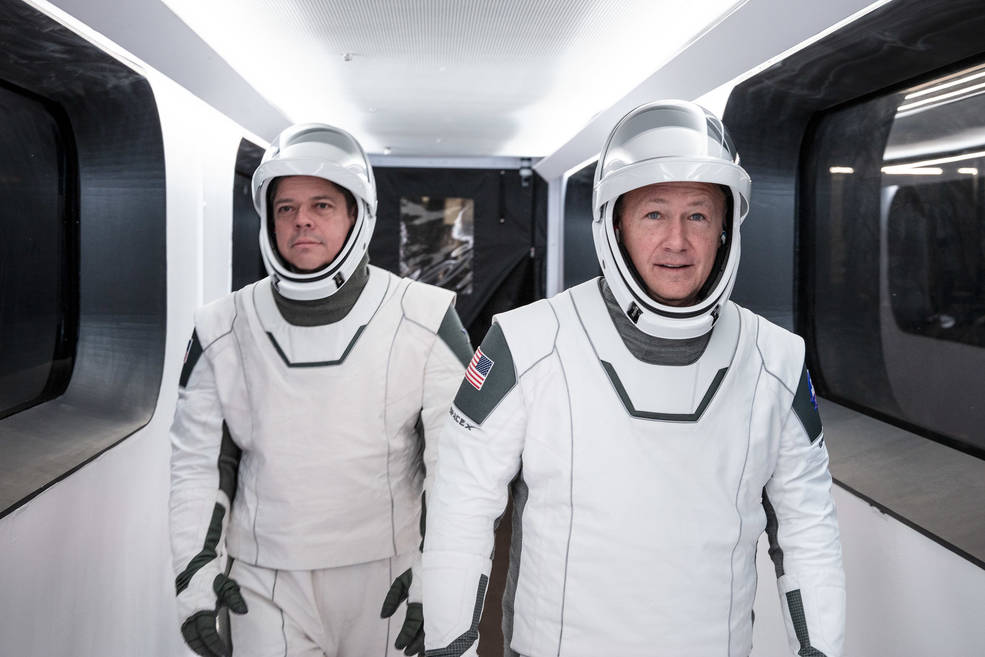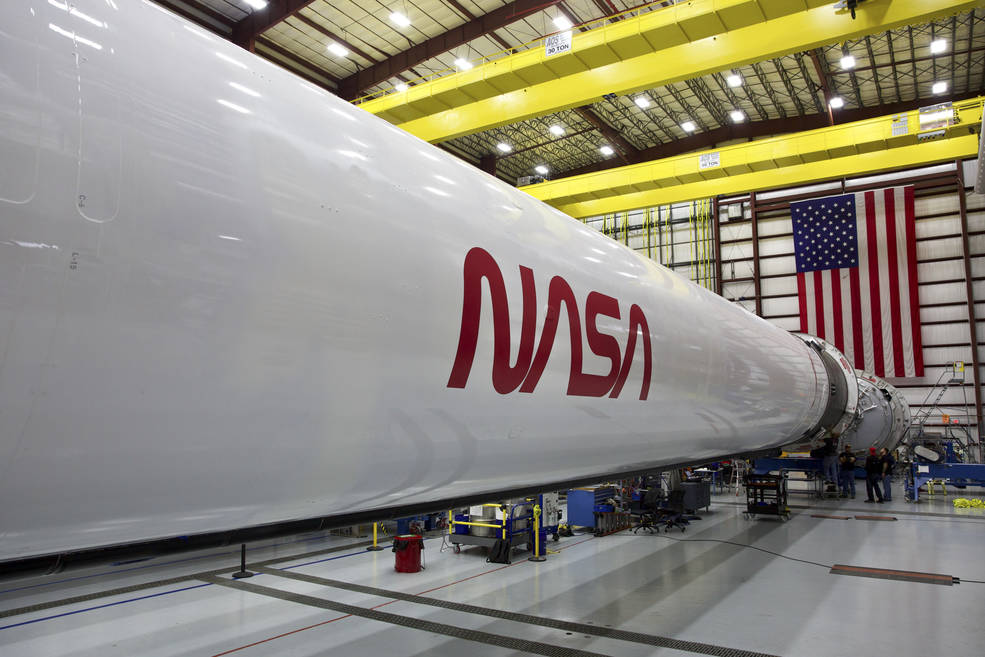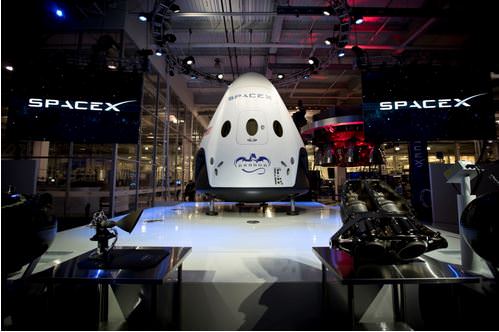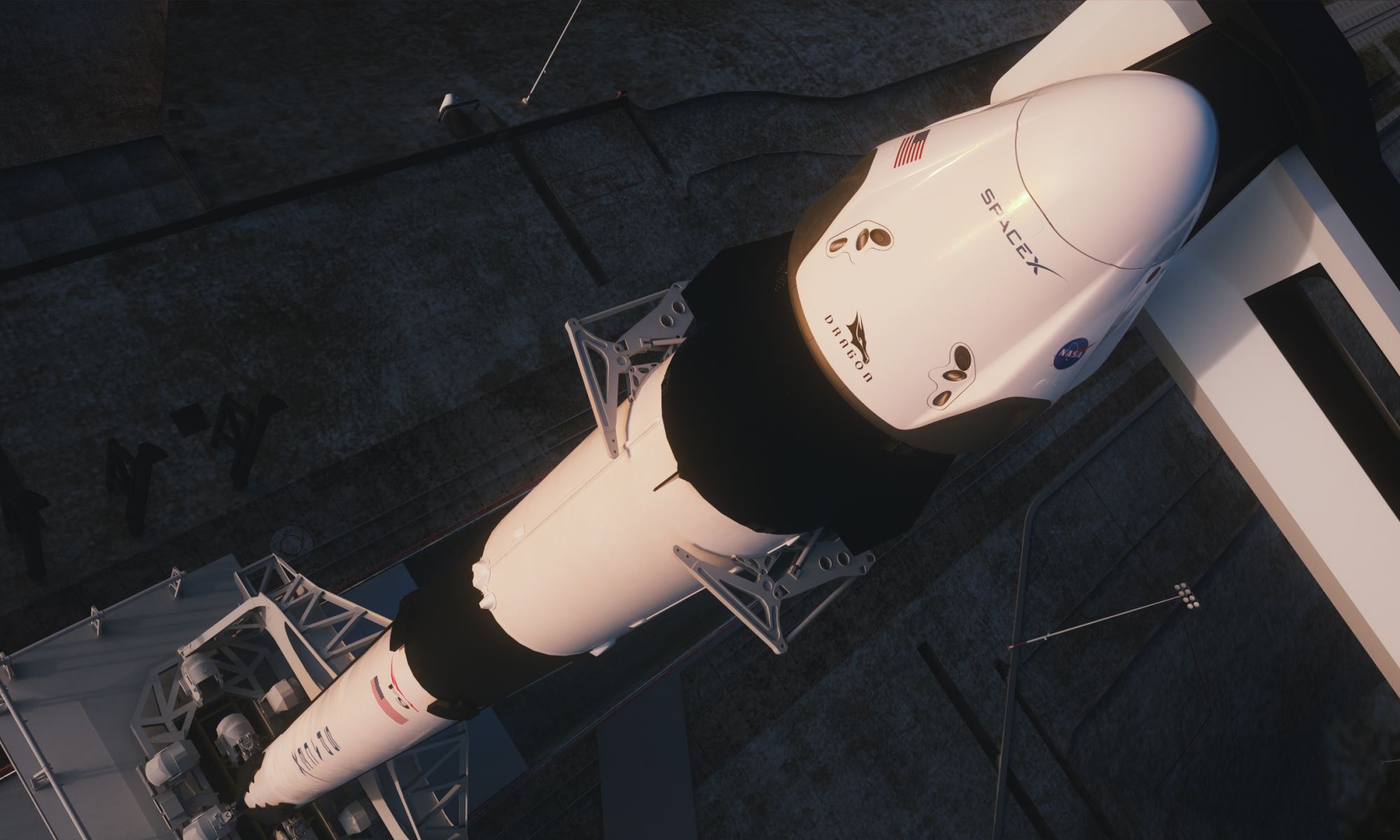NASA and SpaceX are targeting May 27, 2020 for an historic mission: the launch of the first astronauts on the SpaceX Crew Dragon spacecraft, with the destination as the International Space Station (ISS). The crew, NASA astronauts Robert Behnken and Douglas Hurley, are scheduled to launch on a Falcon 9 rocket at 4:32 pm EDT that day from Kennedy Space Center’s Launch Complex 39A. If all goes well, the Crew Dragon will autonomously dock with the space station about 24 hours later.
NASA is heralding the mission, dubbed Demo-2, as a new era of human spaceflight and SpaceX bills it as turning point for America’s future in space exploration. Indeed, this scheduled flight will be the first crewed mission launched from the U.S. since the final space shuttle flight on July 8, 2011, which also took off from Kennedy Space Center’s Launchpad 39A. Ever since the space shuttle’s retirement, NASA astronauts have flown to the ISS on Russian Soyuz rockets, launched from the Baikonur Cosmodrome in Kazakhstan.

The duration of the Demo-2 mission has not been officially announced, but is rumored to last about two weeks, with Hurley and Behnken joining the three current occupants of the ISS, NASA astronaut Chris Cassidy and Russian cosmonauts Anatoly Ivanishin and Ivan Vagner. Hurley and Behnken have both flown on the space shuttle, and while in space for this mission, will perform tests on Crew Dragon in addition to conducting research and other tasks with the space station crew.
Of course, this launch to space is set to take place during an unprecedented time on Earth. Much of the world is staying at home in an effort to slow down the spread of the coronavirus. NASA has faced criticism for scheduling the flight at this time, but somehow they list it as essential.
NASA Administrator Jim Bridenstine has said that the US needs access to the ISS, and that “it’s essential for our country to have that capability.”
However, NASA also says they are “proactively monitoring the coronavirus (COVID-19) situation as it evolves. The agency will continue to follow guidance from the Centers for Disease Control and Prevention and the agency’s chief health and medical officer and communicate any updates that may impact mission planning or media access, as they become available.”
Scheduling the flight means that hundreds of NASA and SpaceX employees are required to be on-site at KSC, Johnson Space Center in Houston and SpaceX’s mission control in Hawthorne, California. Hurley and Behnken will need to be quarantined so they don’t bring the virus to the ISS, but yet will need to be in contact with workers at KSC, who will reportedly wear personal protective equipment when necessary to reduce the chances of spreading COVID-19.
In normal times, the announcement of the launch date would have sent space journalists and reporters like myself scrambling to make flight arrangements and accommodations to be on hand to witness the launch. But due to COVID-19 concerns, I won’t be attending the launch, and other journalists are making that decision as well. But some journalists have said they are prepared to make whatever sacrifices are necessary to attend in-person.
One journalist, who has covered space shuttle missions since the 2000s, yet asked not to be named for fear of not being granted access by NASA to cover the mission, and possible retaliation by SpaceX, said they want to attend the launch even though it would put themselves and their family at risk.
“However, the other reality is that Demo-2 is an incredibly important moment in spaceflight history, and being on the ground as a journalist is equally so — especially if anything goes wrong,” the journalist told Universe Today. “The press needs to be there to ask tough questions NASA, SpaceX, and its partners may not want to answer, but should be held accountable for. I wish circumstances were different, and I’d strongly prefer the launch be delayed until we better understand COVID-19, have reliable and widespread testing in place, and contact-tracing methods rolled out that don’t compromise civil liberties. But I also understand what’s at stake in terms of ISS needs for staffing, supplies, and research.”
NASA said they will limit the number of journalists allowed on-site at KSC but have not yet announced how they will manage crowds gathering on Florida beaches and causeways to watch the historic launch, in order to maintain social distancing requirements.
Dragon capsules have been bringing cargo to the ISS since 2012, and in March 2019, SpaceX performed a successful test of the Crew Dragon spacecraft’s ability to autonomously connect with the ISS. However, a second Crew Dragon was destroyed during an abort engine test last April, which prompted a delay in scheduling the Demo-2 flight. The abort engine issue has now been fixed, and SpaceX conducted a successful in-flight abort test this past January.

The Crew Dragon will launch aboard a specially instrumented Falcon 9 rocket. The rocket will accelerate to approximately 17,500 mph to intercept the ISS. During the flight, the crew will test the spacecraft’s control systems and maneuvering thrusters, and conduct more tests once the Crew Dragon is docked. NASA said that although the Crew Dragon being used for this flight test can stay in orbit about 110 days, the specific mission duration will be determined once on station. The operational Crew Dragon spacecraft will be capable of staying in orbit for at least 210 days, per NASA’s requirements.
To bring the two astronauts back to Earth, Crew Dragon will autonomously undock depart the space station and re-enter the Earth’s atmosphere. Upon splashdown just off Florida’s Atlantic Coast, the crew will be picked up at sea by SpaceX’s Go Navigator recovery vessel and return to Cape Canaveral.
NASA says that the Demo-2 mission will be the final major step before NASA’s Commercial Crew Program certifies Crew Dragon for operational, long-duration missions to the space station.
Additional Reading on the Demo-2 flight:
NASA
SpaceX
Info on briefings and interviews about the mission on NASA-TV on May 1, 2020.


